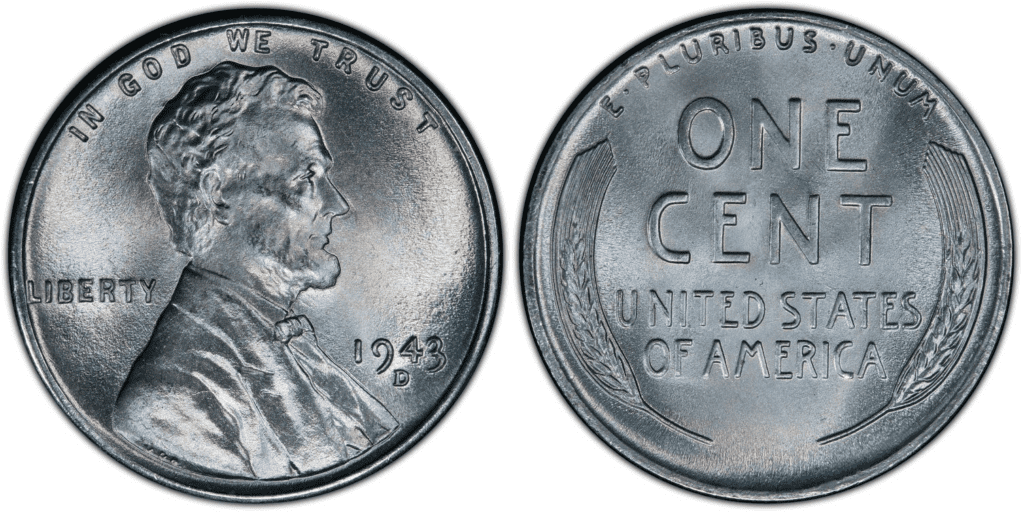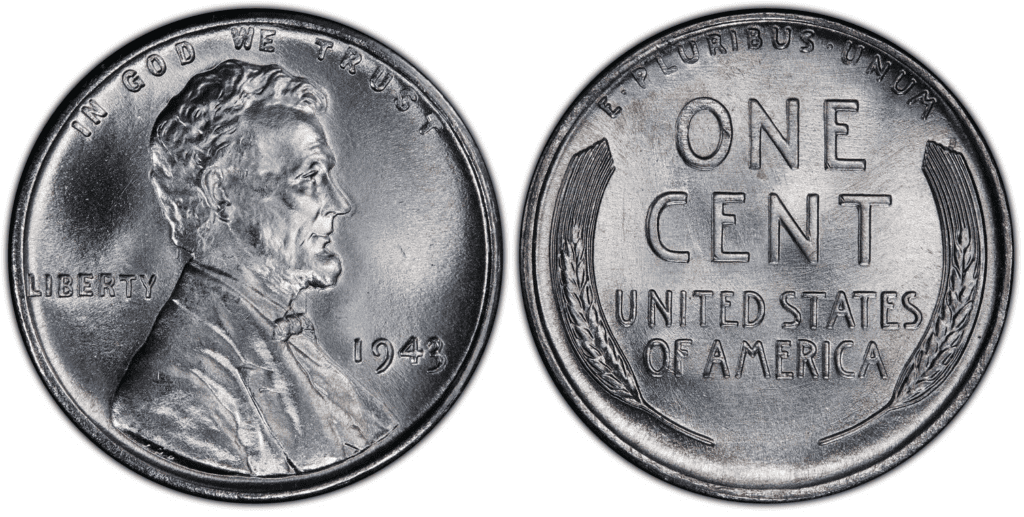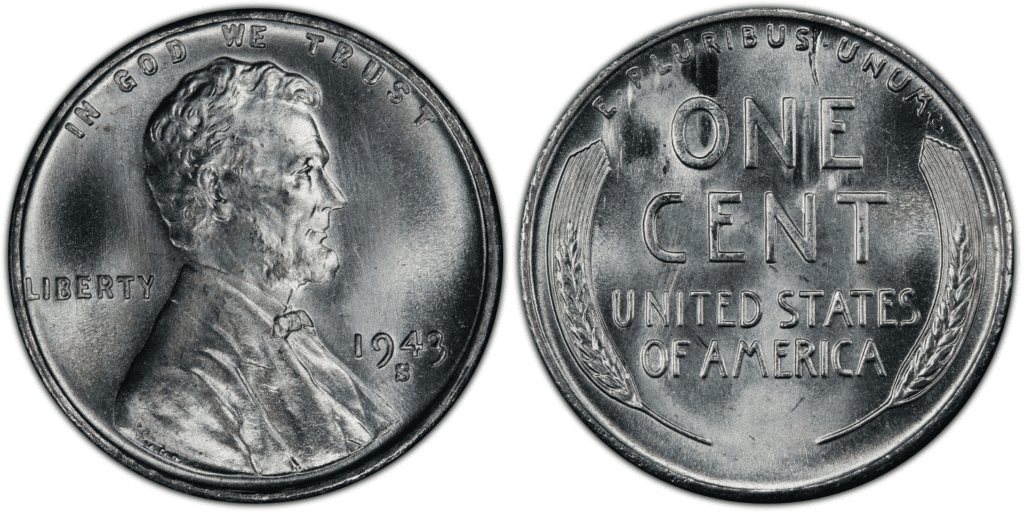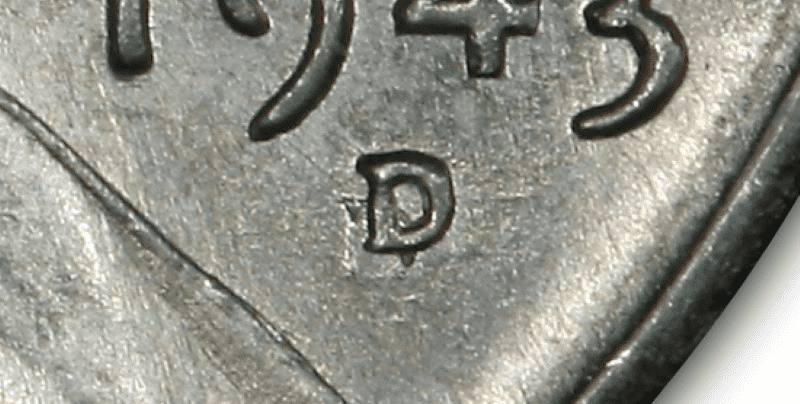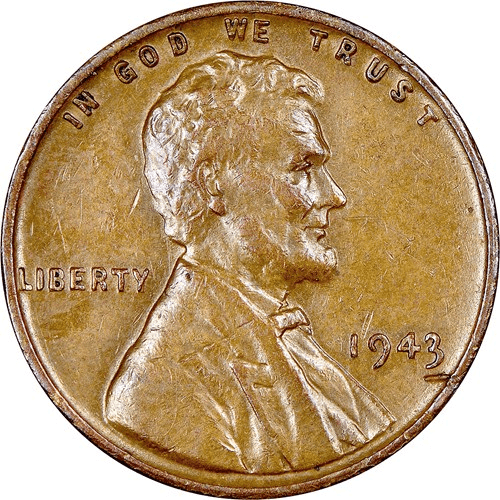What Is the 1943 Lincoln Steel Penny Made Of?
The 1943 Lincoln steel penny is perhaps the most unique type of penny coin in the entire series of Lincoln penny. For one, it is the only year when the Lincoln penny was struck in steel. This means that the 1943 Lincoln steel was made of 99% steel with a little zinc as its coating.
Usually, the Lincoln penny was made of 95% copper and 5% tin and zinc. The composition used for the pennies struck from 1909 to 1942 and from 1944 to 1982. Then, in 1982, the Lincoln cent transitioned to 97.5% zinc and 2.5% copper.
Now, you might ask, why was the 1943 Lincoln penny turned into steel? The simple answer is that the United States was in the middle of World War II. In 1943, there was a shortage of copper. Copper was massively used to win the war overseas. Thus, Congress asked the US Mint to modify the composition of the US coins and remove copper from them as much as possible.
For the 1943 steel, the design essentially stayed the same. The only huge difference was the composition. Victor David Brenner originally made the design.
On the obverse, you’ll find the image of Abraham Lincoln, the 16th president of the United States. The timing couldn’t be more perfect because 1909, the year when the Lincoln penny was first struck, was the same year Lincoln would have celebrated his 100th birth anniversary.
Image source: USA Coin Book
Aside from Lincoln’s image, there are inscriptions added on the obverse. These include the following:
- IN GOD WE TRUST
- LIBERTY
- 1943
- Mint mark (if present)
On the reverse, you’ll find two stalks of wheat, which symbolize hard work and the humble agricultural roots of the United States. Aside from the wheat, there are inscriptions added to the reverse side, which include the following:
- ONE CENT
- UNITED STATES AMERICA
- E PLURIBUS UNUM
The 1943 steel penny got different nicknames, which include steelie, zinc cent, wartime cent, and steel war penny. Deciding to make the penny steel wasn’t easy. There were different experiments to ensure that the one-cent would still be as good as it should be. The alloy used in the steel penny made the coin magnetic and even lighter.
Regrettably, the steel penny didn’t become popular, and the public didn’t like the new coin. For one, the steel penny was easily mistaken to be a dime. Not only that, but vending machines were having problems accepting steel pennies. What’s worse, the steel penny can easily rust when exposed to sweat.
By the 1960s, the 1943 steel penny was taken out of public circulation only to be destroyed by the mint.
Fun fact: the steel penny is the only officially issued coin by the US Mint that sticks to a magnet.
1943 Lincoln Steel Penny Varieties
The 1943 Lincoln steel penny was struck in the Philadelphia, Denver, and San Francisco Mint. As a result, there are three varieties of 1943 Lincoln steel pennies. Here are the official and standard-struck pennies from 1943:
| Variety | Location | Mintage |
| 1943-P Lincoln Penny | Philadelphia | 684,628,670 |
| 1943-D Lincoln Penny | Denver | 217,660,000 |
| 1943-S Lincoln Penny | San Francisco | 191,550,000 |
| Total | 1,093,838,670 |
Aside from these, you’ll also find error coins minted in 1943. The error coins gave rise to different types of steel penny.
With that said, you can go ahead and read more about each of the varieties below:
1943 D Lincoln Wheat Penny
Edge: Smooth
Mint Mark: D
Place of minting: Denver
Year of minting: 1943
Face Value: $0.01 (one cent)
Price: $0.05 to $2 (circulated condition)
Quantity produced: 217,660,000
Designer: Victor D. Brenner
Composition: 95% copper and 5% tin and zinc
Mass: 2.70 grams
Diameter: 19 millimeters
Photo Source: PCGS
When the 1943-D wheat penny and other varieties were released, many people hoarded them due to their unique look. The US Mint produced beautiful steel pennies, and thus, you should be able to find 1943-D Lincoln cents in circulated and uncirculated conditions.
The 1943-D wheat penny becomes scarce in MS68 grade. At the end of 1943, the Denver Mint produced more than 217 million pennies. These pennies can be sold for $0.05 to $2.
1943 P Lincoln Wheat Penny
Edge: Smooth
Mint Mark: none
Place of minting: Denver
Year of minting: 1944
Face Value: $0.01 (one cent)
Price: $0.05 to $0.90 (circulated condition)
Quantity produced: 684,628,670
Designer: Victor D. Brenner
Composition: 95% copper and 5% tin and zinc
Mass: 2.70 grams
Diameter: 19 millimeters
Photo Source: PCGS
The Philadelphia Mint produced the most 1943 steel pennies. The mint issued more than 684 million coins, about three times more than the Denver and San Francisco Mints produced.
1943-P wheat pennies could be sold between $0.05 to $0.90 in a circulated condition. You can earn more if you have a steel penny in mint state.
In 1943, the Philadelphia Mint used a new die to create the steel pennies. So, there were a lot of well-struck steel one-cent coins. Additionally, the Philadelphia Mint recalibrated the striking pressure of their minting machine to engrave inscriptions and design elements deeply.
As a result, the 1943 Steel penny has the most MS68 and even higher graded coins than any other wheat pennies struck from 1909 to 1959.
1943 S Lincoln Wheat Penny
Edge: Smooth
Mint Mark: S
Place of minting: San Francisco
Year of minting: 1943
Face Value: $0.01 (one cent)
Price: $0.05 to $2 (circulated condition)
Quantity produced: 191,550,000
Designer: Victor D. Brenner
Composition: 95% copper and 5% tin and zinc
Mass: 2.70 grams
Diameter: 19 millimeters
Photo Source: PCGS
The San Francisco Mint produced more than 191 thousand wheat pennies in 1943-S. The price may range from $0.05 to $2. However, uncirculated 1943-S should be more valuable.
Collectors and speculators have saved a lot of mint-state steel pennies. Thus, you should be able to find 1943-S pennies in grades MS66 and MS67.
List Of 1943 Lincoln Wheat Penny Errors
There were more than 1 billion wheat pennies produced in 1943. So, there was always the chance that an error coin would come out.
Now, there are different error coins in the 1943 penny series. One of them is the 1943-D/D error. This happens when the D mintmark is struck twice. The error is so prominent that the naked eye can easily see it.
Here’s what the D over D error looks like in a 1943 steel penny:
Image source: PCGS
Another error coin from the 1943 penny series is the 1943 pennies struck on bronze planchets. In 1942, the penny was made of bronze or copper and zinc. Some unused bronze planchets from 1942 made it to the hopper, where they were accidentally struck. So, if you find a 1943 penny made of copper, you’re holding a valuable coin.
Here’s an example of a 1943 penny struck on a bronze planchet:
Image source: NGC
Another common error is the DDO or doubled die obverse. This happens when the die strikes the planchet twice, leaving the penny to have a doubling in some of its engraved elements.
Here’s an example of a 1943 steel penny with a DDO error:
Image source: NGC
The more prominent the DDO error or the doubling, the more valuable the coin would be in the eyes of collectors.
How Much Is The 1943 Lincoln Steel Penny Worth Today?
The 1943 Lincoln steel penny has a face value of 1 cent. Its melt value is lower, which stands at $0.0006.
When looking at the face and melt value, you might think that the steel penny isn’t really that valuable. That’s understandable, but you would be surprised to know that the real value of the 1943 Lincoln steel penny doesn’t lie in its face value and melt value.
They are valuable because of their rarity and good condition. Remember, this coin is already more than 80 years old. So, it carries a great premium value.
To know its real value, take a look at this 1943 Lincoln Steel Penny values chart:
| Coin | Condition | Grade | Mintage | Value |
| 1943 D Lincoln penny | Good | G-4 to G-6 | 217,660,000 | $0.22 |
| 1943 D Lincoln penny | Fine | F-12 to F-15 | 217,660,000 | $0.39 |
| 1943 D Lincoln penny | Extremely Fine | XF-40 to XF-45 | 217,660,000 | $0.50 |
| 1943 D Lincoln penny | Uncirculated | MS-60 to MS-62 | 217,660,000 | $3.30 |
| 1943 D Lincoln penny | Gem Uncirculated | MS-65 to MS-66 | 217,660,000 | $8 to $45 |
| 1943 D Lincoln penny | Superb Gem Uncirculated | MS-67 to MS-68 | 217,660,000 | $111 to $192 |
| 1943 P Lincoln penny | Good | G-4 to G-6 | 684,628,670 | $0.17 |
| 1943 P Lincoln penny | Fine | F-12 to F-15 | 684,628,670 | $0.33 |
| 1943 P Lincoln penny | Extremely Fine | XF-40 to XF-45 | 684,628,670 | $0.45 |
| 1943 P Lincoln penny | Uncirculated | MS-60 to MS-62 | 684,628,670 | $2.81 |
| 1943 P Lincoln penny | Gem Uncirculated | MS-65 to MS-66 | 684,628,670 | $11 to $11,400 |
| 1943 P Lincoln penny | Superb Gem Uncirculated | MS-67 to MS-68 | 684,628,670 | $140 to $4,465 |
| 1943 S Lincoln penny | Good | G-4 to G-6 | 191,550,000 | $0.28
|
| 1943 S Lincoln penny | Fine | F-12 to F-15 | 191,550,000 | $0.45 to $16 |
| 1943 S Lincoln penny | Extremely Fine | XF-40 to XF-45 | 191,550,000 | $0.85 |
| 1943 S Lincoln penny | Uncirculated | MS-60 to MS-62 | 191,550,000 | $6.65 |
| 1943 S Lincoln penny | Gem Uncirculated | MS-65 to MS-66 | 191,550,000 | $14 to $100 |
| 1943 S Lincoln penny | Superb Gem Uncirculated | MS-67 to MS-68 | 191,550,000 | $146 to $4,800 |
| 1943 P cent struck in a bronze alloy | Uncirculated – Mint State | MS-63 | Exact number is unknown | $164,500 |
As you can see, the 1943 Steel penny can be very expensive. To know the full selling price potential of this coin, take a look at the following auction records for each variety:
- $218,500 – a 1943 1C (Regular Strike) with a grade of AU58 sold in January 2010 by Heritage Auctions
- $164,500 – a 1943 bronze cent with a grade of MS63
- $138,000 – a 1943-S 1C (Regular Strike) with a grade of AU58 sold in March 2004 by the American Numismatic Rarities
- $14,250 – a 1943-D 1C (Regular Strike) with a grade of MS68+ sold in August 2022 by eBay
How Does The Grading System Work?
The Sheldon Scale is used by numismatists to provide a numerical value to coins. The Sheldon Scale goes from poor (P-1) to perfect mint state (P-1) (MS-70). Coins were originally evaluated using words to reflect their condition (Good, Fair, Excellent, Etc.). Unfortunately, coin collectors and dealers had different ideas about what each of these terms represent.
Professional numismatists joined together in the 1970s and established CoinGrading standards. These numismatists now assign grades at key places on the seventy-point scale, using the most regularly utilized numeric points in conjunction with the original adjective grade. The following are the most common coin grades:
-
-
- (P-1) Poor – Indistinguishable and probably damaged; if used, must have a date and mintmark; otherwise, rather battered.
- (FR-2) Fair – Nearly smooth, but without the damage that a coin graded Poor often possesses. The coin must have enough detail to be identified.
- (G-4) Fair – Inscriptions have merged into the rims in some areas, and important elements have been mostly erased.
- (VG-8) Very Good- A little weathered, but all of the primary design elements are visible, albeit faintly. There is little if any, central detail left.
- (F-12) Good – The item is very worn, yet the wear is even, and the overall design details stand out clearly. Rims are almost completely isolated from the field.
- (VF-20) Very Fine – Moderately weathered, with some finer features still visible. The motto or all letters of LIBERTY are readable. Both sides of the coin have entire rims that are separated from the field.
- (EF-40) Extremely Fine – Gently used; all gadgets are visible, and the most important ones are bold. The finer details are bold and clear, however, light wear may be seen.
- (AU-50) Uncirculated – Slight evidence of wear on the coin’s design’s high points; may have contact marks; eye appeal should be adequate.
- (AU-58) Uncirculated Choice – Slight traces of wear, no severe contact marks, almost full mint shine, and great eye appeal.
- (MS-60) Mint State Basal – Strictly uncirculated; no indication of wear on the coin’s highest points, but an unsightly coin with reduced luster, visible contact marks, hairlines, and other flaws.
- (MS-63) Mint State Acceptable – Uncirculated, but with contact scratches and nicks, little reduced shine, but otherwise appealing appearance. The strike is weak to average.
- (MS-65) Mint State Choice – Uncirculated with great mint shine, very little contact blemishes, and exceptional eye appeal. The strike is unusually severe.
- (MS-68) Mint State Premium Quality – Uncirculated with superb luster, no obvious contact marks to the naked eye, and exceptional eye appeal. The strike is quick and appealing.
- (MS-69) Almost Perfect Mint State – Uncirculated with perfect brilliance, a sharp and appealing strike, and extremely good eye appeal. A near-perfect coin with minor imperfections in the planchet, strike, and contact markings (seen only under 8x magnification).
- (MS-70) Mint State Perfect – Under 8x magnification, there are no tiny imperfections discernible; the strike is crisp, and the coin is perfectly centered on a beautiful planchet. Rarely seen on a coin, this coin is bright and whole, with original luster and exceptional eye appeal.
-
Where To Buy Or Sell 1943 Lincoln Steel Penny?
The 1943 Lincoln steel penny is available both online and offline. If you are the techy type, you can immediately go to eBay or Amazon. These websites are known to have a great number of pennies for sale. Aside from that, these marketplaces also allow you to sell your items. Create a free account, and you’re ready to go.
You can also go to Google and search for what you need. You can use keywords such as “Where to buy a 1943 Lincoln steel penny” or “Where to sell a 1943 Lincoln steel penny.” You should then get a lot of helpful links.
Aside from the Internet, you can visit coin shops, pawnshops, auction houses, and antique stores. These places are known to have coins for sale. They can also buy your coins. If you can, try to join groups or clubs of coin collectors. The more people you know, the more chances you’ll have in selling or buying 1943 Lincoln steel pennies.
FAQs
Does the 1943 Lincoln Steel Penny have no mint?
The 1943 Lincoln steel pennies from the Philadelphia Mint don’t have mint marks. However, pennies from San Francisco have the S mint mark, while pennies from Denver have the D mint mark.
How do I know if my 1943 steel penny is rare?
The 1943 steel penny is rare when it is still in good condition. It can be considered rare if you have graded your coin and received a grade of at least MS68. Moreover, a 1943 bronze penny is the rarest variety in this series.
What makes a 1943 S steel penny rare?
A 1943 S steel penny becomes rare when it has received a grade of at least MS68.


